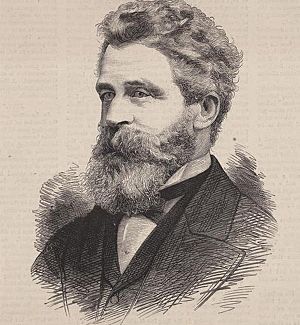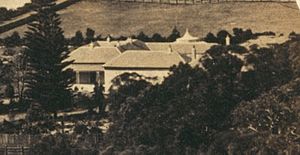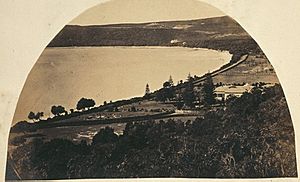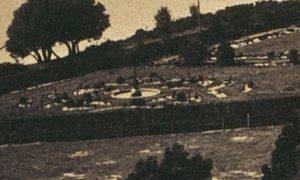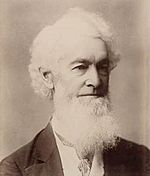Salisbury Court (Rose Bay) facts for kids
Quick facts for kids Salisbury Court |
|
|---|---|
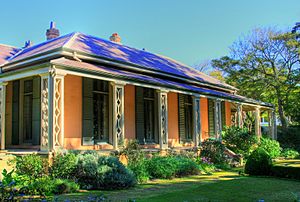
A restored Salisbury Court, or Rose Bay Cottage, pictured in 2010.
|
|
| Location | 1-7 Salisbury Road, Rose Bay, Sydney, Australia |
| Built | 1834–1915 |
| Architect | John Verge (original cottage) |
| Official name: Salisbury Court; Rose Bay Lodge; Rose Bay Cottage | |
| Type | State heritage (built) |
| Designated | 2 April 1999 |
| Reference no. | 251 |
| Type | Homestead building |
| Category | Residential buildings (private) |
| Lua error in Module:Location_map at line 420: attempt to index field 'wikibase' (a nil value). | |
Salisbury Court is a historic building in Rose Bay, Sydney, Australia. It was once an apartment building and a large home. Today, it is a private residence. The original house was designed by a famous architect named John Verge. It was built between 1834 and 1915.
This building is also known as Rose Bay Lodge or Rose Bay Cottage. It is very important because it is the oldest house still standing in the Woollahra area. The property was added to the New South Wales State Heritage Register on April 2, 1999. This means it is protected for its historical value.
Contents
History of Rose Bay Cottage
How Rose Bay Land Was Settled
The land where Salisbury Court stands was once part of a huge area. This area was given to two businessmen, Daniel Cooper Snr and Solomon Levey, in 1830. They were partners in a company called Cooper & Levey. Before them, a military officer named Captain John Piper owned parts of this land. He had a large house called Henrietta Villa nearby.
In 1826, Captain Piper faced financial trouble. So, his land went to Cooper & Levey. By 1830, they owned about 530 hectares (1,320 acres) of land. This stretched from Woollahra to Rose Bay. Most of it was wild bushland back then.
Cooper & Levey did not develop the land much. Solomon Levey moved to London in 1826. Daniel Cooper also left Sydney in 1831. While they were away, James Holt managed their business. He was Daniel Cooper's cousin. In 1834, James Holt became a partner in the company.
Building the First Rose Bay Cottage
James Holt wanted a house away from the busy city. In September 1834, he asked John Verge, a well-known architect, to design a cottage. This cottage was planned for Rose Bay.
Newspapers at the time reported on the new building. The Sydney Gazette said in November 1834 that Mr. Holt had started building a "commodious residence" (a comfortable home). In April 1837, The Sydney Times mentioned "the pretty residence of Mr Holt" in Rose Bay.
Sir Daniel Cooper's Home
James Holt lived in the cottage until about 1843. That year, Daniel Cooper Jnr. (who later became Sir Daniel) arrived in Sydney. He was Daniel Cooper Snr.'s nephew. Daniel Cooper Jnr. inherited a large part of the land.
It is believed Daniel Cooper Jnr. lived in the cottage from 1844 to 1848. His eldest son, also named Daniel, was born there in 1848. Daniel Cooper Jnr. was born in England in 1821. He came to Australia as a child, then returned to England for school. He came back to Australia in 1843 and became a business partner with James Holt.
In 1846, Daniel Cooper Jnr. married Elizabeth Hill. They lived in the cottage until 1848. After they moved out, the cottage was rented to James Moffitt. He was a famous stationer and bookseller.
Sir Daniel Cooper returned to the cottage in 1855. By this time, he was a member of Parliament. He was also the Speaker of the New South Wales Legislative Assembly. He made many improvements to the garden. A photo from 1855 shows a beautiful fountain in the grounds. A visitor named Francis Grundy described the house as having "crisp trim lawns and splashing fountain."
Sir Daniel Cooper lived at Rose Bay Cottage while his new, grander house, Woollahra House, was being built nearby. After he moved out, Walter Lamb lived there for a short time. Then, Sands Directories show that Sir John Hay lived there from 1866 until he died in 1892.
Sir John Hay's Time at Rose Bay Lodge
Sir Daniel Cooper left Australia in 1861 and did not return permanently. The cottage then became known as Rose Bay Lodge. It is thought that Sir John Hay moved in around 1867. He was appointed a Member of the Legislative Council (MLC) that year.
Sir John Hay was born in Scotland in 1816. He came to Sydney in 1838. He became a successful farmer and then a politician in 1856. He was elected Speaker in 1862. He was a very keen gardener. He may have added even more to the garden at Rose Bay Cottage. He also owned another piece of land nearby called "The Garden." This land was used as an experimental nursery for plants.
Sir John and Lady Hay did not have children. When they both died in 1892, his property went to his brother's children. After Sir John Hay's death, the house was leased to Rosa Rougier. She eventually bought it in 1900.
The Rougier Family and Later Owners
Rosa Rougier moved into Rose Bay Cottage in 1893. In 1895, she married Dr. Emile Rougier. He was the Director of the Pasteur Institute. The Rougiers loved to host parties. Newspapers often mentioned their social events. In 1902, they held a large garden party. The Sydney Morning Herald reported that the "charming grounds of Rose Bay Lodge were quite en fete."
Rosa Rougier died in Paris in 1910. Rose Bay Cottage was put up for sale in February 1911. The advertisement described it in great detail. It said the house had "delightfully laid out grounds" of about seven acres. It had "extensive harbour views." The house itself was large and well-built. It had many rooms, including eight bedrooms and three bathrooms. There were also stables and a separate small cottage.
Later in 1911, the property was sold as "Rose Bay Lodge Estate." It was divided into 37 smaller plots of land. The house itself was sold separately on four plots. Victor Louis Bosker Haigh and Grace Ann Friedericks bought the house and its current grounds. They later sold it to Leah Abrahams in 1912. After her death, it was passed to other owners.
Deterioration and Restoration
In 1912, a new owner bought the house and turned it into "Ritz Flats." Over the next 70 years, many changes were made to the building. These changes were not in keeping with its original style. By the 1980s, the house was almost unrecognizable.
In 1983, the Heritage Council of New South Wales stepped in. They wanted to protect the property. The owners argued that restoring it would be too expensive. The Heritage Council looked at different ways to use the building. They considered turning it into a retirement village, a conference center, or offices. They hoped a new owner would restore the historic cottage.
Rose Bay Lodge (originally Rose Bay Cottage) is important because it is the oldest house in Woollahra. The first part of the house was built in 1834. It was designed by John Verge, a very skilled architect. Many original details, like plaster cornices and French doors, are still there. The house shows how colonial homes grew over time to fit the needs of families.
In 1993, Peter Bracher bought the house. He hired architect Alan Croker and builder Peter Harris to restore it. They used as many of the original materials as possible.
In 2015, a special plaque was placed outside Rose Bay Cottage. It honors Sir Daniel Cooper. He was the first elected Speaker of the New South Wales Legislative Assembly. He was also a generous person who helped many people. He was given special titles like Knight and Baronet. The name of his new house, "Woollahra," was later used for the local area.
Heritage Significance
As of 2011, Rose Bay Lodge is the oldest house still standing in the historic Woollahra area. It was the family home of the Cooper family from 1855 to 1861. The Coopers owned the Woollahra Estate and gave the area its name.
The house is linked to important people:
- Sir Daniel Cooper: He was the first Speaker of the New South Wales Legislative Assembly.
- Sir John Hay: He was a very important politician in New South Wales in the late 1800s.
- Other important people like Daniel Cooper Sen., Solomon Levey, James Holt, William Moffit, and Walter Lamb also lived there.
The building is a rare example of a single-story colonial cottage from before the 1840s. It was designed by John Verge, a leading architect of his time. It used to be a famous landmark on Sydney Harbour. The remains of its fountain are among the oldest in a private garden in Sydney. It is also rare because it still has its original domestic wing and service courtyard.


